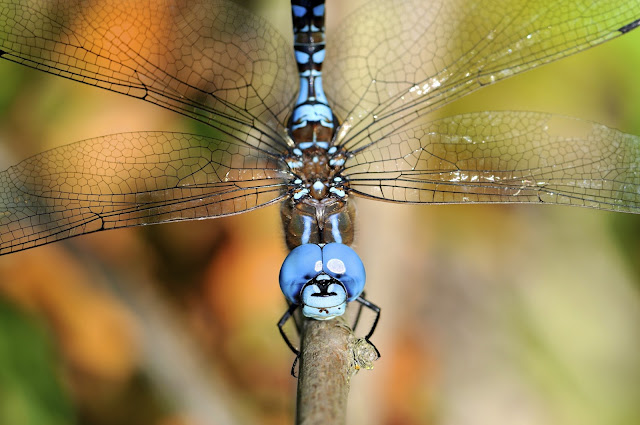In my case, the dragonflies involved were Autumn Meadowhawks. These friendly dragonflies, which like to land on people, are a common sight at Cranberry Lake in Anacortes, Washington late in the season.
 |
Betsy experiences a red dragonfly on the shoulder, and a second one on her hat. Both dragonflies are male Autumn Meadowhawks, the friendliest dragonfly we know.
|
Autumn Meadowhawks are well described by a famous haiku:
Red dragonfly on my shoulder,
Calls me his friend.
Autumn has arrived.
I’ve often had them “on my shoulder,” but last autumn I had them covering my entire body – literally from head to toe. Here’s what happened.
I went to
Cranberry Lake on November 9, 2011 to observe the dragonfly activity. The weather was sunny and calm, with an
air temperature of 57 ˚F. On other
similar days I would observe about a dozen Autumn Meadowhawks and half a dozen
Shadow Darners. On this day, however, I immediately
realized something was different – there were so many Autumn Meadowhawks on the gravel walking path that I
had to choose my steps carefully to keep from stepping on them.
I walked to
some bushes near the shore to see if any darners were perched there, but as
soon as I stood still for a moment the meadowhawks began to gather on me. It felt like a scene from Hitchcock’s
movie, The Birds. They were landing all over me in a
frenzy. I took some pictures
showing the ones perched from my waist down, but as
I took those pictures I could feel them perched on my arms, my upper body, my
head, even on my face. The
pictures show over 30 on my lower body, and I would estimate there were 50 or
more on my body as a whole. I’ve
had several Autumn Meadowhawks land on me before, but never anything like
this.
 |
| A gathering of Autumn Meadowhawks at Cranberry Lake in Anacortes, Washington on November 9, 2011. |
 |
The ones pictured on my lower body are only half the story – they covered me from head to toe. It felt like a scene out of The Birds.
|
After taking a few pictures I looked up and saw that the air was just “full” of meadowhawks flying in all directions, hooking up in tandem or attempting to hook up. It was similar to a mass flight of winged ants or termites. A few darners were flying too, picking off individual meadowhawks, and also pairs in tandem, and heading for the bushes or trees to enjoy their catch. It was quite a scene. It’s hard to estimate the number of meadowhawks, but it must have been in the several hundreds.
I decided to go home and bring Betsy to see this phenomenon. As I walked back to the car the meadowhawks went along for the ride on my body. The car was a considerable distance away, and in the shade, but there were still a dozen or more dragonflies on me when I got there. I had to “shoo” them away to keep them from getting in the car with me – though one managed to do so anyway.
When Betsy and I returned a few minutes later, the activity level was a bit lower, though still intense. We marveled at the meadowhawks that seemed to be everywhere we looked, including all over us. Along the shore we observed an egg-laying frenzy, with intense competition for prime sites. As a result of the competition, many meadowhawks were being knocked into the water where they became stuck. We ended up rescuing a dozen or more.
As we watched the egg-laying activity, the shadows of the afternoon (it was about 2:00 pm at this point) began to lengthen. We expected to see the meadowhawks moving along the shore to stay in the sunlit areas, but at one point – quite suddenly – we noticed that the egg laying had ceased, and the air was now clear of meadowhawks. It was almost as if someone had flipped a switch. We’re not sure what the signal for stopping was – it wasn’t evident to us – but the meadowhawks seemed to respond en masse.
We returned the next several days, but each time the activity was completely normal again, with just a dozen or so meadowhawks along the shore. The mass behavior seen on November 9 was a short-lived phenomenon, but one we’re happy to have experienced.













